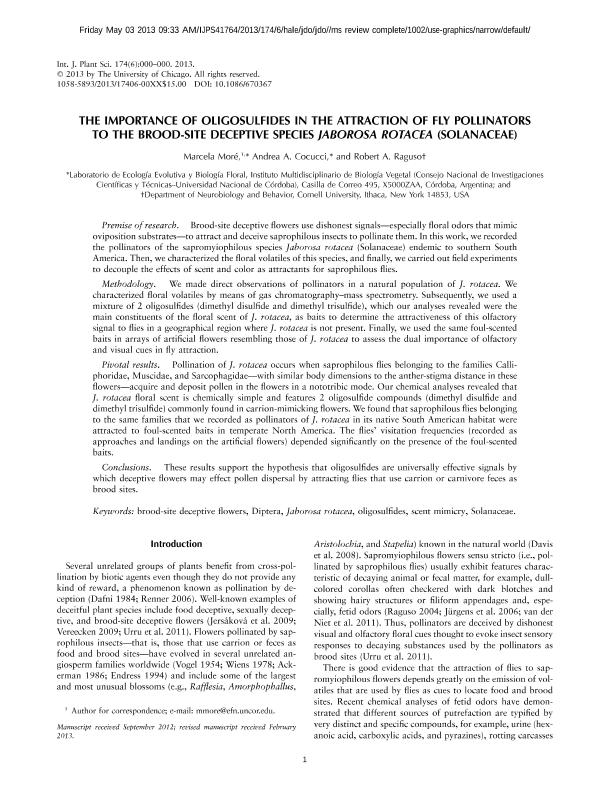Mostrar el registro sencillo del ítem
dc.contributor.author
More, Marcela

dc.contributor.author
Cocucci, Andrea Aristides

dc.contributor.author
Raguso, Robert A.
dc.date.available
2015-07-23T12:58:20Z
dc.date.issued
2013-04
dc.identifier.citation
More, Marcela; Cocucci, Andrea Aristides; Raguso, Robert A.; The importance of oligosulfides in the attraction of fly pollinators to the brood-site deceptive species Jaborosa rotacea (Solanaceae).; University of Chicago Press; International Journal of Plant Sciences; 174; 6; 4-2013; 863-876
dc.identifier.issn
1058-5893
dc.identifier.uri
http://hdl.handle.net/11336/1416
dc.description.abstract
Premise of research. Brood-site deceptive flowers use dishonest signals-especially floral odors that mimic oviposition substrates-to attract and deceive saprophilous insects to pollinate them. In this work, we recorded the pollinators of the sapromyiophilous species Jaborosa rotacea (Solanaceae) endemic to southern South America. Then, we characterized the floral volatiles of this species, and finally, we carried out field experiments to decouple the effects of scent and color as attractants for saprophilous flies. Methodology. We made direct observations of pollinators in a natural population of J. rotacea. We characterized floral volatiles by means of gas chromatography-mass spectrometry. Subsequently, we used a mixture of 2 oligosulfides (dimethyl disulfide and dimethyl trisulfide), which our analyses revealed were the main constituents of the floral scent of J. rotacea, as baits to determine the attractiveness of this olfactory signal to flies in a geographical region where J. rotacea is not present. Finally, we used the same foul-scented baits in arrays of artificial flowers resembling those of J. rotacea to assess the dual importance of olfactory and visual cues in fly attraction. Pivotal results. Pollination of J. rotacea occurs when saprophilous flies belonging to the families Calli-phoridae, Muscidae, and Sarcophagidae-with similar body dimensions to the anther-stigma distance in these flowers-acquire and deposit pollen in the flowers in a nototribic mode. Our chemical analyses revealed that J. rotacea floral scent is chemically simple and features 2 oligosulfide compounds (dimethyl disulfide and dimethyl trisulfide) commonly found in carrion-mimicking flowers. We found that saprophilous flies belonging to the same families that we recorded as pollinators ofJ. rotacea in its native South American habitat were attracted to foul-scented baits in temperate North America. The flies' visitation frequencies (recorded as approaches and landings on the artificial flowers) depended significantly on the presence of the foul-scented baits. Conclusions. These results support the hypothesis that oligosulfides are universally effective signals by which deceptive flowers may effect pollen dispersal by attracting flies that use carrion or carnivore feces as brood sites.
dc.format
application/pdf
dc.language.iso
eng
dc.publisher
University of Chicago Press

dc.rights
info:eu-repo/semantics/openAccess
dc.rights.uri
https://creativecommons.org/licenses/by-nc-sa/2.5/ar/
dc.subject
BROOD-SITE DECEPTIVE FLOWERS
dc.subject
DIPTERA
dc.subject
JABOROSA ROTACEA
dc.subject
OLIGOSULFIDES
dc.subject
SCENT MIMICRY
dc.subject
SOLANACEAE
dc.subject.classification
Ciencias de las Plantas, Botánica

dc.subject.classification
Ciencias Biológicas

dc.subject.classification
CIENCIAS NATURALES Y EXACTAS

dc.title
The importance of oligosulfides in the attraction of fly pollinators to the brood-site deceptive species Jaborosa rotacea (Solanaceae).
dc.type
info:eu-repo/semantics/article
dc.type
info:ar-repo/semantics/artículo
dc.type
info:eu-repo/semantics/publishedVersion
dc.date.updated
2016-03-30 10:35:44.97925-03
dc.journal.volume
174
dc.journal.number
6
dc.journal.pagination
863-876
dc.journal.pais
Estados Unidos

dc.journal.ciudad
Chicago
dc.conicet.avisoEditorial
Author can archive post-print (ie final draft post-refereeing). On a not-for-profit author's personal server, institutional server, subject-based pre-print server including institutional repository, or open access repository
dc.description.fil
Fil: More, Marcela. Consejo Nacional de Investigaciones Científicas y Técnicas. Centro Científico Tecnológico Conicet - Córdoba. Instituto Multidisciplinario de Biología Vegetal. Universidad Nacional de Córdoba. Facultad de Ciencias Exactas Físicas y Naturales. Instituto Multidisciplinario de Biología Vegetal; Argentina
dc.description.fil
Fil: Cocucci, Andrea Aristides. Consejo Nacional de Investigaciones Científicas y Técnicas. Centro Científico Tecnológico Conicet - Córdoba. Instituto Multidisciplinario de Biología Vegetal. Universidad Nacional de Córdoba. Facultad de Ciencias Exactas Físicas y Naturales. Instituto Multidisciplinario de Biología Vegetal; Argentina
dc.description.fil
Fil: Raguso, Robert A.. Cornell University; Estados Unidos de América;
dc.journal.title
International Journal of Plant Sciences

dc.relation.alternativeid
info:eu-repo/semantics/altIdentifier/doi/http://dx.doi.org/10.1086/670367
Archivos asociados
